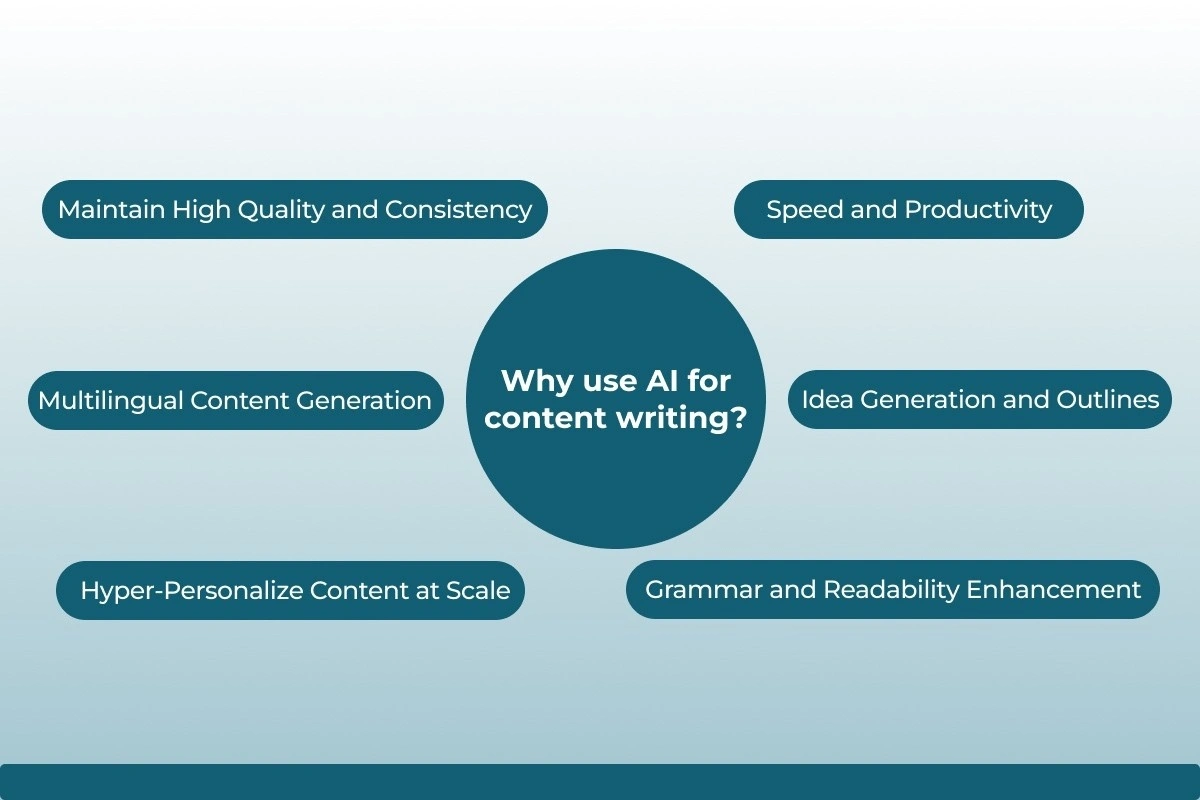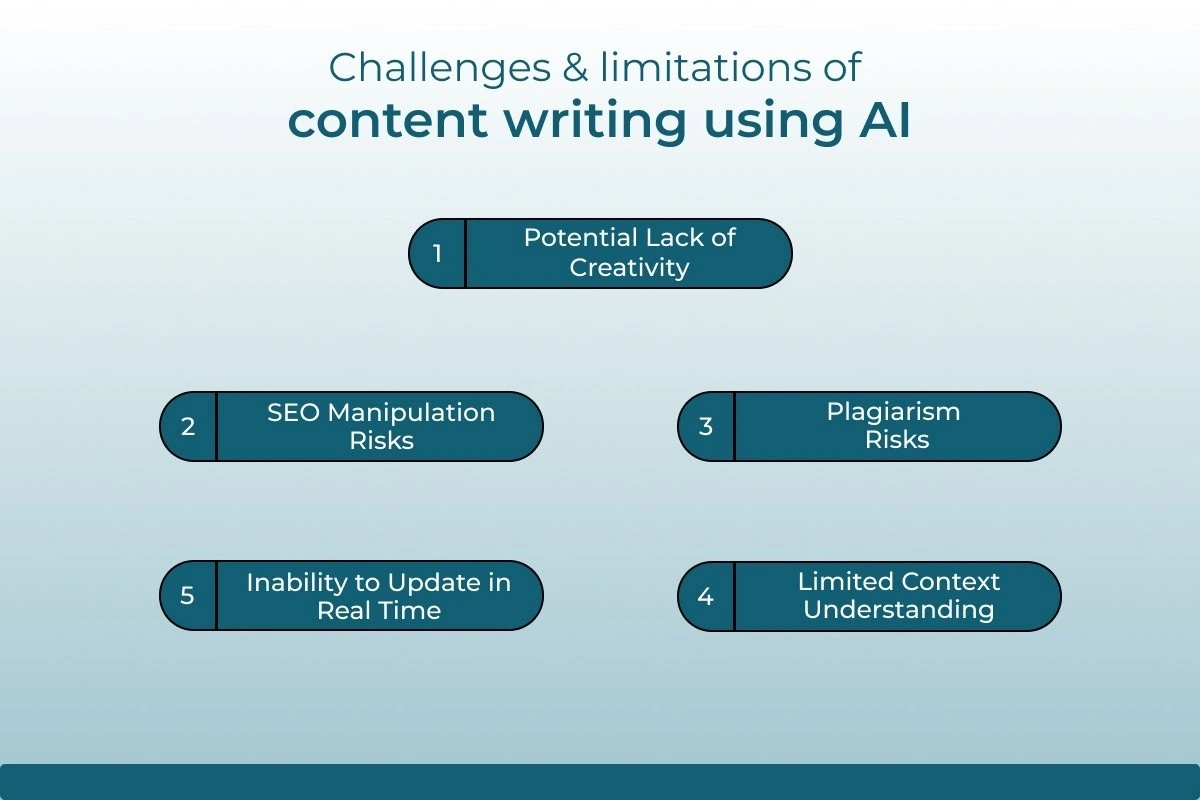Artificial intelligence is strongly influencing how digital content is growing and changing. Using AI tools allows marketers, businesses, and content creators to handle their jobs better, work faster, and stay ahead of others.
AI makes it possible to quickly come up with ideas, draft content, edit it, and keep it updated. As AI is advancing, it is becoming necessary to use it in content strategies to be relevant and provide good content.
In this blog, we’ll explore what AI in content writing is, how it works, why it matters, and most importantly, how you can effectively use it to craft better-performing content.
What is AI in content writing?
AI in content writing means using tools or algorithms to generate, edit, and optimize written content. They rely on machine learning, natural language processing (NLP), and deep learning to study prompts, determine the intent, and deliver responses written like a human.
As an example, AI assistants like ChatGPT, Jasper, Copy.ai, and Writesonic help generate blog posts, ad content, emails, and social media captions with only minor input from humans. Grammarly AI helps make sentences easier to understand and appropriately toned, and tools such as SurferSEO or Clearscope guide writers in writing content that matches what people search for.
Why use AI for content writing?
Consistent, quality content is needed everywhere, and AI steps in to address the main issues content teams encounter today.

Here are the reason why use AI for content writing:
- Speed and Productivity: AI can quickly create outlines, drafts, and whole articles, making the process much faster than a person can. As a result, teams can increase their content production fast, without setting aside important deadlines..
- Idea Generation and Outlines: When you are struck with writer’s block, AI is ready to add new topics, outline suggestions, and help with interesting headlines. It gets you past writer’s block and ensures the process of creating content goes without hitches.
- Grammar and Readability Enhancement: Thanks to AI tools like Grammarly and Hemingway Editor, you can polish sentence formation, repair erroneous grammar points, and make an article easier to read. This way, your content turns out smooth, professional, and captivating to read.
- Hyper-Personalize Content at Scale: AI helps companies personalize their product descriptions, emails, or landing pages for distinct customer groups. Businesses can adapt email messages, descriptions of products, and landing pages to suit particular customers. Creating this type of personal experience boosts how active users are and results in more conversions.
- Multilingual Content Generation: AI helps businesses create content in many languages. Companies can translate their content into many languages and provide it to customers around the globe. It becomes very helpful when a business wants to enter a new market.
- Maintain High Quality and Consistency: AI guarantees that all types of content and platforms stay consistent in their tone, voice, and style. This also ensures your company’s brand stands out and all messages are delivered in a professional way.
How to use AI for content writing?
To use AI well for generating content, you need to do more than just feed prompts into a writing tool. The combination of automation and how people understand the problem helps a lot in getting results.

Here’s a step-by-step guide to integrating AI into your content process, so you get better results, work faster, and increase your outcomes:
1. Define your content goals
The first step should be to decide the purpose of your content. Is it more important for you to attract natural visitors, provide valuable content, raise engagement, or turn visitors into leads?
Clearly stating your objectives will lead the AI to write content in a way that fits your intent. A clear objective means your message will not wander and will always stay important to your audience.
2. Conduct keyword research with AI
After deciding on your goal, make use of tools like SEMrush, Ahrefs, or SurferSEO to find excellent keywords for your search engine optimization. Search volume, user intent, and rival websites are studied by these systems to come up with clusters of topics that could bring in readers.
Keyword research is now done faster and with better accuracy using AI. It can spot out smaller opportunities and connect terms automatically, which you might not spot with only manual attempts.
3. Generate a content outline with AI
Following your research, using AI software such as ChatGPT, Jasper, or Notion AI can create an organised outline for your content. The outlines usually contain recommended headings, subheadings, and an order for the content, which helps the writing process stay organized.
A clear outline helps your article be thorough and well-positioned for search engines. Developing a good plan here leads to a more organized and inspiring draft.
4. Draft content using AI writing assistants
When the outline is finished, you can easily create the first draft using Copy.ai or Writesonic. You can quickly get a full article by giving these tools prompts and structure.
Being precise in what you say will make the AI create good and relevant content. During the first draft, you can record your ideas quickly, but the draft needs to be improved.
5. Optimize for SEO
When drafting is complete, utilize Frase, SurferSEO, or Clearscope to help your content rank well with search engines. They look over top-ranking sites and assess how your content is organized, which keywords you’re using, and how thorough it is in comparison to the competition.
They suggest semantic keywords, frequently asked questions, and how to make the website’s SEO better. By taking this step, your site appears more often in search results, and the content matches what users want to find.
6. Edit & humanize AI-generated content
Still, the content generated by AI can sound uninteresting, which is why editing by real writers is very important. Put in your brand personality, personal stories, real-life cases, or references to your area to connect better with people.
This step lets you make changes, adjust the mood, and guarantee your content is accepted by your audience. What makes AI output unique and true-to-life is including a real person’s touch.
7. Add visuals & enhance engagement
Connecting content to engaging visuals such as infographics, screenshots, or videos helps it succeed. Meanwhile, these elements add welcome breaks, simplify hard-to-follow messages, and help users spend more time on the site.
Right now, Canva and similar platforms allow you to produce these assets very efficiently. Sharing your posts on social platforms becomes easier with visual content.
8. Publish & monitor performance
When your content is up and running, start monitoring its results using both Google Analytics and Search Console. AI software can review the bounce rate, how much time users spend on each page, and the paths they follow during conversions.
Following how your users act allows you to find out what content is most successful. To keep improving, your strategy needs this feedback loop.
9. Update content with AI for long-term SEO
Ranking content may lose its position if it is not updated as time goes on. AI may identify if old information is no longer valid, links are broken, or the engagement on those posts is lower.
Take these findings and make updates to your content using available new data and design, and remember to keep your SEO in check. It keeps your website competitive and makes sure it doesn’t drop in ranking.
Challenges & limitations of content writing using AI
Even though AI has changed content creation for the better, it still has some problems. If you know what AI cannot do, you will treat it as something that helps your ideas, not something that replaces them.

Here are some of the challenges and limitations of content writing using AI:
- Potential Lack of Creativity: AI tools are excellent in managing data and copywriting styles, yet a human writer has more original ideas and can share feelings and stories richer than machines. Therefore, the AI cannot truly create stories that people can relate to.
- SEO Manipulation Risks: When AI-generated content is not controlled properly, keyword stuffing and other SEO manipulations may happen. Following such methods might make your site less trustworthy and could result in Google handing out penalties.
- Plagiarism Risks: Even though AI does not directly copy works, it can sometimes use words or styles that were fed into it while being trained. Thus, it is important to look for plagiarism before publishing, since the risk of borrowing content is high.
- Limited Context Understanding: AI is not always able to pick up on language or topics that are particular to one industry, unless the prompt provides plenty of specific information. As a consequence, what is written can be very general or inaccurate, which can disappoint experts.
- Inability to Update in Real Time: AI tools aren’t up to date, as they must connect with live APIs or search engines to use real-time data. As a result, the information, trends, and statistics they give may not reflect current trends unless you update them.
Best practices for using AI in writing
It’s important to handle AI carefully while writing, so you can keep it authentic and of good quality. Using these tips will allow you to make the best use of technology and preserve creativity in your content.
- Use AI as a Helper, Not a Replacement: AI should make your writing easier by helping you organize, complete tasks faster, and come up with ideas. Still, a human influence is important, most of all when it comes to telling a story, triggering emotions, and handling strategic messages.
- Mix AI Output with Human Insights: Make sure to modify the content produced by AI by adding your point of view, real-world cases, and a distinctive voice. It allows your content to be unique and much easier for your followers to relate to.
- Focus on Your Audience’s Needs: Even though AI can arrange and smooth out your content, only you truly understand what your audience wants and how they feel. A human writer must always put in empathy, the right tone, and meaningful interaction.
- Review and Update Content Regularly: Make sure outdated or missed opportunities are found in your articles by using AI. Frequent updates help your content stay up to date, current, and relevant as things change online.
- Monitor Performance Using Tools like Google Analytics and Search Console: It is necessary to use Google Analytics and Search Console to observe the performance of your site. Follow how your content is doing by looking at website traffic, user actions, and the rate of conversion. They help develop your strategy and give both you and the AI lessons for the future.
Conclusion
AI has completely changed the content writing field by making it faster, more efficient and better for search engine ranking. If used properly, it helps you work faster, stimulate ideas and ensure everything is done the same way. It reaches its greatest potential when human insights, artistic skills and knowledge of the film industry are also included.
Getting the proportions right permits you to share content that has solid data as well as feels real and captures the audience’s attention. You can use AI to help you grow your content strategy or adjust your messaging.
Ready to elevate your content game? Partner with Digital Terai and harness the future of intelligent content creation.



